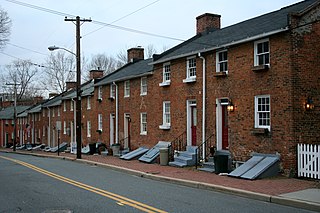
Oella is a mill town on the Patapsco River in western Baltimore County, Maryland, United States, located between Catonsville and Ellicott City. It is a 19th-century village of millworkers' homes.
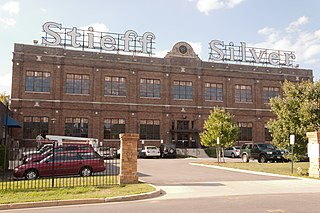
The Stieff Company, Silversmiths, Goldsmiths & Pewterers, located in Baltimore, Maryland, is also known as Kirk-Stieff after 1979.

Silver Spring station is a historic building located at Silver Spring in Montgomery County, Maryland on the Metropolitan Subdivision. It was built in 1945 on the foundation of the original station, a Victorian-style brick structure built in 1878. It was designed in the Colonial Revival style and built from standardized plans developed for B&O stations in the mid-1940s.
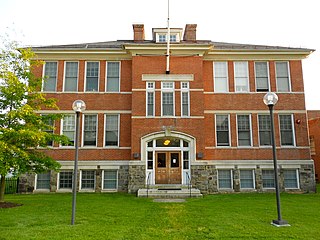
Howard Park P.S. 218, also known as School 7, is a historic elementary school located at Baltimore, Maryland, United States. It is an early 20th-century brick school building located in the intact historic west Baltimore neighborhood of Howard Park. The earliest school building was constructed in 1908 and enlarged in 1913, 1936, and in 1957. The older sections are built of brick and accented with limestone details. It continued to function as a school until 1980.

Building at 409 West Baltimore Street, also known as the N. Hess & Bro. Building, is a historic retail and wholesale building located at Baltimore, Maryland, United States. It is a four-story brick commercial building with a cast-iron façade above an altered storefront, erected about 1875. Built originally for a wholesale grocery company, it was subsequently occupied by a boot and shoe factory, and a series of wholesale and retail dry goods or clothing stores.

Heiser, Rosenfeld, and Strauss Buildings, also known as Inner Harbor Lofts I, is a historic loft building located at Baltimore, Maryland, United States. It is a complex of three structures. The Heiser Building is a Romanesque Revival style, six-story brick, stone, and iron structure, eight bays wide and 14 bays deep, built as a show factory in 1886. The Rosenfeld Building is a six-story, five-bay loft building, with Beaux Arts styling and built for E. Rosenfeld and Company in 1905. The Strauss Building is a six-story high, six-bay wide, and 11-bay deep loft structure built in 1887 for the Kinny Tobacco Company, cigarette manufacturers, and later occupied by the Strauss Brothers, clothing manufacturers and became part of the Rosenfeld complex around 1910.

Gunther Brewing Company is a historic brewery industrial building complex, located in the Canton neighborhood of southeast Baltimore, Maryland,. The site comprises 15 masonry buildings. The main structure is a five-story brick "L"-shaped Romanesque Revival-style brew house with a two-story brick ice plant built about 1910 and one- and two-story boiler room. Additional brew houses built in 1936 and 1950 are also on the property. The later Tulkoff factory and warehouse was built about 1964. It was home to the George Gunther, Jr. Brewing Company, founded in 1900. By 1959, it was the second largest brewery in Baltimore, one of the major centers of brewing in America, when it produced 800,000 barrels per year and employed approximately 600 people. Hamm's Brewing Company bought the Gunther Brewing Company in 1960, and later became part of Miller Brewing Company. Later the brand was acquired just three years later by the F. & M. Schaefer Brewing Company in 1963, the plant in Canton was closed in 1978. The Tulkoff company briefly used the factory for their sauce products at the conclusion of all brewing operations.

H.F. Miller & Son Tin Box and Can Manufacturing Plant, or the American Can Company, Miller Factory, and now Miller Court is a historic can manufacturing plant located at Baltimore, Maryland, United States. It was erected in three stages between 1890 and about 1910. It is a four-story brick manufacturing plant. The exterior features decorative brickwork, multiple window forms, and substantial construction typical of the period. The interior features chamfered posts, closely spaced joists, and fire doors.

L. Grief and Bro., Inc. Manufactory is a historic factory building located at Baltimore, Maryland, United States. It is a three-story brick and steel industrial building constructed about 1914–15. It features an expanse of multi-light steel windows, a metal cornice, and sawtooth monitors. It encompasses almost an entire city block and over 60,000 square feet (5,600 m2) of interior space. It served as a clothing factory for L. Greif & Bro., Inc., makers of the men's clothing brand, 'Griffin,' and for a time the country's second-largest men's clothing company. The company was sold to a national conglomerate in 1957.

Bagby Furniture Company Building is a historic factory building located at Baltimore, Maryland, United States. It is a four-story, "U"-shaped, brick factory building composed of three sections constructed between 1902 and 1907. Its exterior features segmental and jack arches above openings, a corbeled watertable, and a corbeled cornice. It housed the Bagby Furniture Company, which operated from 1879 to 1990.

Coca-Cola Baltimore Branch Factory is a historic factory complex located at Baltimore, Maryland, United States. It was constructed from 1921 to 1948 and built principally to house Coca-Cola's syrup-making operations. The complex is spread over a 9.4-acre (38,000 m2) site and includes a two-story brick syrup factory/sugar warehouse and an earlier two-story brick mattress factory that Coca-Cola acquired and adapted in the 1930s. Completed in 1948, the complex housed syrup-making operations as well as the Coca-Cola Company's chemistry department.

Maryland White Lead Works is a historic lead paint factory complex located at Baltimore, Maryland, United States. It is a "U"-shaped industrial complex constructed about 1867. It consists of nine interconnected brick and wood-frame buildings, which vary in height from one to four stories, surrounding a yard. The complex includes the powerhouse, two production sheds, a manufactory loft with an office wing, and a service building. The Maryland White Lead Company occupied the site from 1867 to 1896, Baltimore's first and most substantial manufacturer of lead paints.

National Enameling and Stamping Company is a historic factory complex located at Baltimore, Maryland, United States. It was constructed in 1887 to serve as the works of the Baltimore branch of the nation's largest tinware manufacturer, the National Enameling and Stamping Company (NESCO). The densely packed complex fills an almost 5-acre (2.0 ha) site and consists of 17 interconnected buildings and one structure that vary in height from one to five stories. The complex was organized to house three primary functions in discrete sections: the manufacture of tinware, the manufacture of enameled and japanned wares, and storage, warehousing, and distribution. The plant ceased production of tinware and enameled wares in 1952.
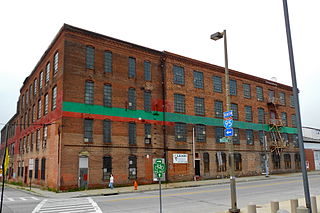
Parker Metal Decoration Company Plant is a historic factory building located at Baltimore, Maryland, United States. It is a steel-frame brick industrial building, ranging from one to three stories in height, and consists of five components built in stages between the first decade of the 20th century and the 1940s. The Parker Metal Decorating Company operated between 1921 and 1994.

Procter and Gamble Baltimore Plant is a historic factory complex located at Locust Point in Baltimore, Maryland, United States. It is a compact industrial complex built by the national corporation Procter & Gamble comprising five major three-story brick buildings spread over 10 acres (40,000 m2). These major buildings are the Process Building (1929), the Soap Chip Building (1929), the Bar Soap Building (1929), the Warehouse (1929), and the Tide Building (1949).

Market Center is a national historic district in Baltimore, Maryland, United States. It is an approximately 24-block area in downtown Baltimore that includes buildings associated with the development of the area as Baltimore's historic retail district. The area evolved from an early 19th-century neighborhood of urban rowhouses to a premiere shopping district featuring large department stores, grand theaters, and major chain stores. The diverse size, style, scale, and types of structures within the district reflect its residential origins and evolution as a downtown retail center.
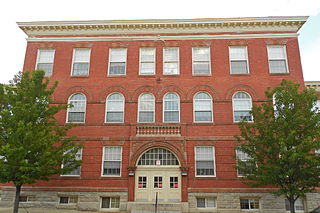
Franklin Square Historic District is a national historic district in Baltimore, Maryland, United States. It is a 19th-century rowhouse neighborhood developed along a strict grid street pattern. A one square block, two and a half acre public park, Franklin Square, is a focal point for the area and the most elaborate rowhousing surrounds the square. The district contains approximately 1,300 buildings of which approximately 1,250 contribute to the significance of the historic district.
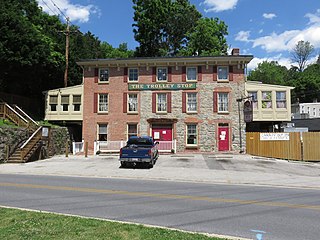
Ellicott's Mills Historic District is a national historic district at Oella, Baltimore County, Maryland, United States. It is on the east bank of the Patapsco River, opposite Ellicott City. It relates to the industrial operations of the Ellicott family from the 1770s through the mid-19th century. It consists of the sites of historic buildings including: an 18th-century building, a section of an 18th-century mill incorporated in a 20th-century factory, a 19th-century tavern, 19th-century workers housing, and an 1859 Italianate villa built by John Ellicott, united by the major east–west route in Maryland during the early 19th century, the old National Pike. Also in the district is the mammoth multi-story Wilkins-Rogers Company flour plant, which is located on the site of the 1792 Ellicott Flour Mill, the first merchant flour mill in the United States.

The community of Wyman Park is a border community that links Hampden to Roland Park. All of the Wyman Park areas were annexed to Baltimore City in 1888. The general boundaries consist of the area from south to north between 33rd Street and 40th Streets and west to east from Keswick Road to Wyman Park. South of 40th Street, garden apartments, multi-story apartment buildings, and single-family residences have been built. People here tend to relate to the north along 40th Street and University Parkway and The Johns Hopkins University. The Wyman Park also accommodates the Union Soldiers and Sailors Monument, located at 29th and Charles Street, and the now removed Stonewall Jackson and Robert E. Lee Monument that has been rededicated as Harriet Tubman Grove on Art Museum Drive.

The American Ice Company is a historic ice manufacturing plant located at 2100 West Franklin Street in Baltimore, Maryland, United States. It is a large industrial brick building designed by Mortimer & Company and constructed by Fidelity Construction in 1910-11 for the American Ice Company, a business that manufactured and delivered ice throughout the Mid-Atlantic and South. The building is two stories, with the brick laid in American bond, and is 21 bays long. Three of those bays at one end of the building are slightly projected and topped by a stepped parapet, forming the entrance area of the building.
























